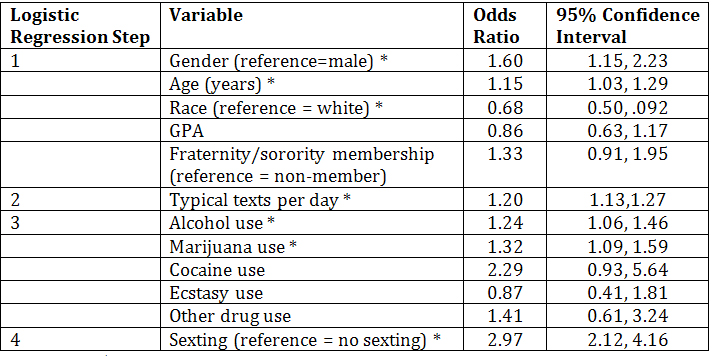Although concerns about alcohol and drug misuse among youth are longstanding, concerns about cell phone misuse are more recent. For example, worries about “sexting” are popular (e.g., Husdon, 2014). Sexting refers to sending sexual content via text messages. Both substance misuse and sexting have the potential for harmful consequences. This week, STASH considers the relationships between youths’ “sexting” behaviors and other risky activities (Benotsch et al., 2013). This article is part of our Special Series on Addiction within Relationships.
Method
- Participants included undergraduates aged 18-25 who were enrolled in psychological classes and participated in research studies for course credit.
- The analytic dataset included 793 students (66% female; 53% Caucasian; 65% Freshman), which represents approximately 50% of those who completed any course credit study at the university during the same semester.
- Participants completed a survey that included questions related to demographics (e.g., age, sex) and past 3-month texting and sexting (e.g., total number of sexual images ever sent), substance use (e.g., frequency of alcohol and marijuana use), and sexual behavior, including risky sexual behavior (e.g., number of unprotected vaginal or anal sex acts).
- A stepwise logistic regression examined how well demographics, substance use behavior, and sexting behavior predicted sexually risky behavior.
Results
- Participants who reported sexting (43% of the sample) were more likely to also report recreational alcohol, marijuana, ecstasy, and cocaine use than those who did not.
- As Table 1 shows, both alcohol and marijuana use and sexting behavior were associated with more risky sexual behavior. Those who reported sexting were nearly 3 times more likely to report risky sexual behavior.

Figure. Stepwise logistic regression of recent unprotected sexual behavior, including odds ratios and 95% confidence intervals. Click image to enlarge.
Limitations
- The analytic sample is narrowly defined (i.e., majority white female college Freshman taking psychology courses), so it is unclear how well these findings will generalize to other youth.
- The experimental design does not permit the detection of a causal relationship between sexting and the other variables of interest.
Conclusion
These results are consistent with other studies that suggest risky behaviors tend to co-occur (Baskin-Sommers & Sommers, 2006). Such studies suggest the need for multi-faceted and multi-targeted prevention and intervention programs. However, focusing on texting or sexting as a risky activity in of itself is likely to have drawbacks. As quickly as people adapt to new technologies, other technologies develop. For instance, Snapchat—a photo messaging app that allows users to make their photos only viewable for 1-10 seconds— might complicate attempts to influence adolescents’ sexting behavior and its associated behaviors. In addition, recent research suggests that youth texting, even texts that are sexual in nature, is occasionally associated with positive public health outcomes (i.e., safer sex; Widman et al., in press). Moving forward, it is important to consider ways to optimize the latest technological advances for public health advantage.
-Debi LaPlante
What do you think? Please use the comment link below to provide feedback on this article.
References
Baskin-Sommers A. & Sommers I. (2006). The co-occurrence of substance use and high-risk behaviors Journal of Adolescent Health, 38, 609-11.
Benotsch, E.G., Snipesa D. J., Martin, A.M., and Bull, S.S. (2013) Sexting, Substance Use, and Sexual Risk Behavior in Young Adults Journal of Adolescent Health, 52, 307–313.
Hudson, L. (2014). You’ve Been Sexting a Lot More, Study Shows. WIRED http://www.wired.com/underwire/2014/02/sexting-relationship-report/. Retrieved February 25, 2014.
Widman, L., Nesi, J. Choukas-Bradley, S., & Prinstein, M.J. (in press). Safe Sext: Adolescents’ Use of Technology to Communicate About Sexual Health With Dating Partners. Journal of Adolescent Health doi:10.1016/j.jadohealth.2013.12.009




